Shiraz is regarded as one of the birthplaces of Iran’s most illustrious empires and is one of the historical and cultural towns in Iran with a significant role in Iranian tourism. The city offers a wide variety of tasty Shiraz souvenirs, so there are many different ways to take a piece of this amazing city back home. As a visitor from outside Iran, you should be aware that Shiraz has excellent traditional pastries and amazing market artwork.
Of course, a lot of Shiraz souvenirs and handicrafts aren’t just available in this particular city; you can also get them in other Iranian cities. Here are some delicious and handmade gifts from Shiraz and the province of Fars that you may pick up while you’re there for friends and family:
Edible souvenirs
Shiraz is fortunate to have a lovely natural setting and a wide range of fruits as a result of its position. They have created the tastiest foods in combination with the inhabitants’ preferences. You should be aware as a foreign visitor that Shiraz’s traditional sweets have excellent flavor. Typical menu items include regional baked foods and customary treats.
The good news is that in addition to being able to consume these meals while visiting Shiraz, you can also bring some delectable mementos from Shiraz’s back home. Some well-known and delectable food mementos that you may purchase for yourself and your family are listed below:
Shirazi Faloodeh
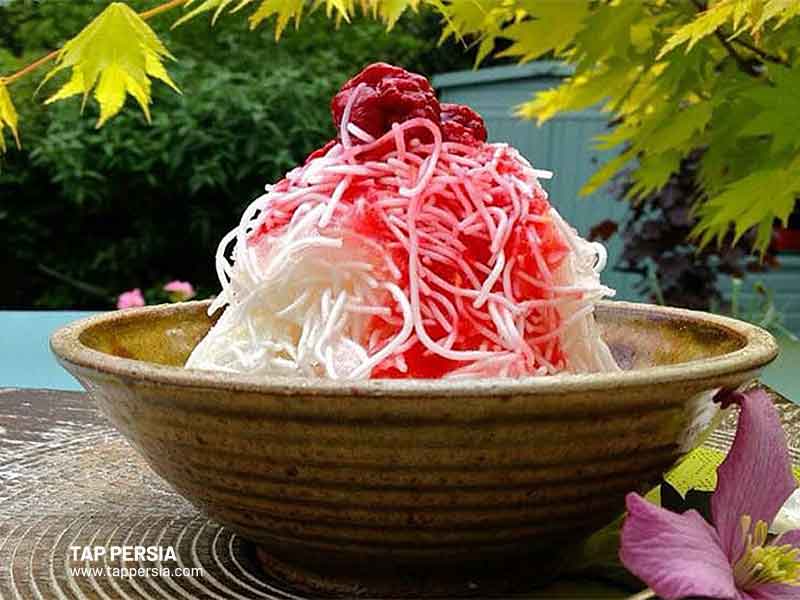
The good news for dessert enthusiasts is that they may sample Shiraz’s unique Faloodeh. Falude is sometimes compared to Turkish sorbet, but not really. A semi-frozen syrup composed of sugar and rose water is combined with thin vermicelli noodles made from corn starch to make this Iranian cold dessert which is also known as Faloudeh or Paloodeh. It is a customary Iranian dessert (Persia).
It can be served with cherry, lemon, or floral essence. As early as 400 BCE, it was one of the oldest types of cold sweets. Shirazi Ice cream is really tasty and distinctive and is created with milk, vanilla, saffron, and almonds. So make sure to consider one of the delicious Shirazi souvenirs that are really popular among locals and tourists.
Yokhe (Kaak)
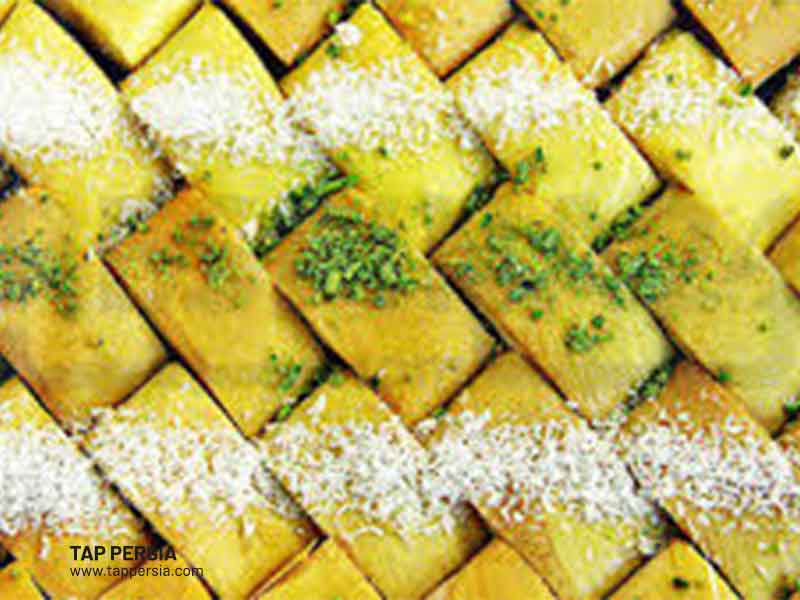
Yokhe, a type of Iranian pastry made with thin dough, is one of the most well-known Shiraz souvenirs.
The dough is covered with cinnamon and powdered sugar before being rolled out and cut into Yokhe. They should first roll up numerous layers of thin dough and sprinkle it with icing sugar, cinnamon, or pistachio powder.
This dessert is made in other towns outside Shiraz as well. For instance, in the province of Kermanshah, this dessert is known as Kaak. The bread’s thickness is the only distinction between Yokhe and Kaak. The dough for yokhe is thinner. It is strongly advised that you sample some of these intriguing delicacies while you are in Shiraz.
Masqati
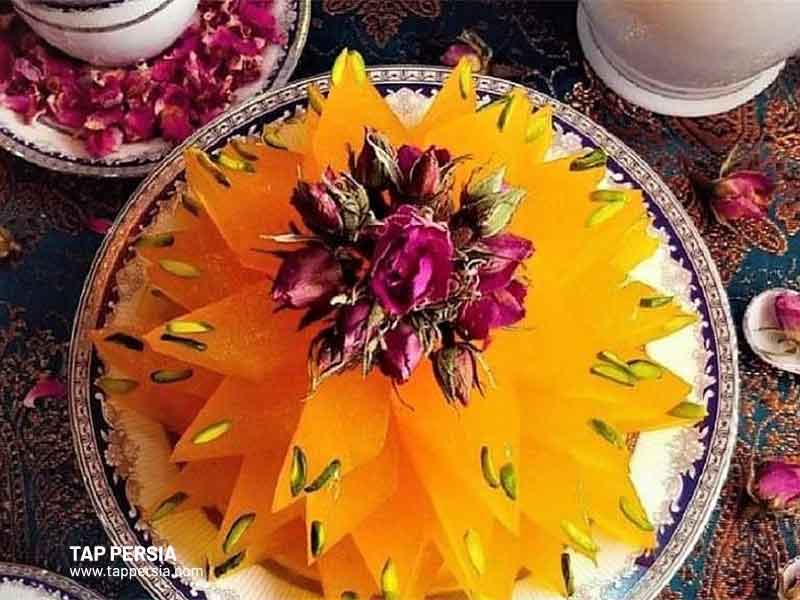
Another one of the most famous Shiraz souvenirs is called Masghati or Muscat; it is a sort of Halva made with flour and pistachio nuts. This tasty Shiraz souvenir is actually from the city of Larestan but is widely regarded as one of the Shiraz souvenirs. Particularly the variety of masghati produced in the Shiraz county of Larestan is said to have a unique flavor and texture.
Slices of almonds are used as a garnish on this soft candy, which is prepared from flour, water, oil, and sugar. Shiraz Masghati is prepared in a variety of flavors and hues, making it ideal for all palates. Various varieties of saffron, pistachio, Damask rose (Mohammadi flowers), berberis, etc. are used in this pastry.
Masghati finds its way to Iranian festivals like Nowruz because of its sweet flavor and appetizing look. It frequently appears with Shiraz’s well-known muffins.
Candied almonds (Badam Sookhteh)
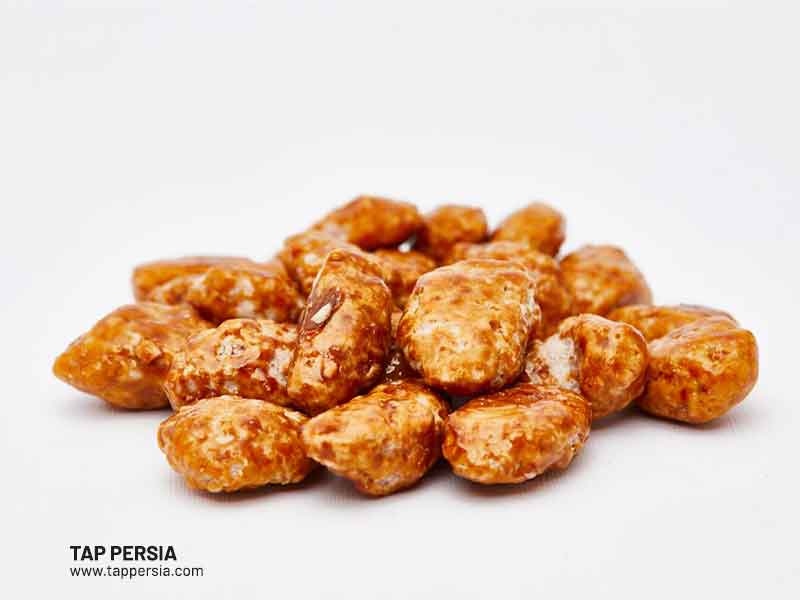
A classic Iranian treat made with whole almonds is candied almonds, also known as Badam Sookhteh, which you may purchase as a souvenir from Shiraz.
Almonds, sugar, and water are combined and cooked to create this sort of confection. Almonds are given a sweet coating in this way, creating a crunchy and flavorful sweetness. Nowadays, candied almonds can be found in mixed nuts and even certain foods.
Shiraz Herbal Essences
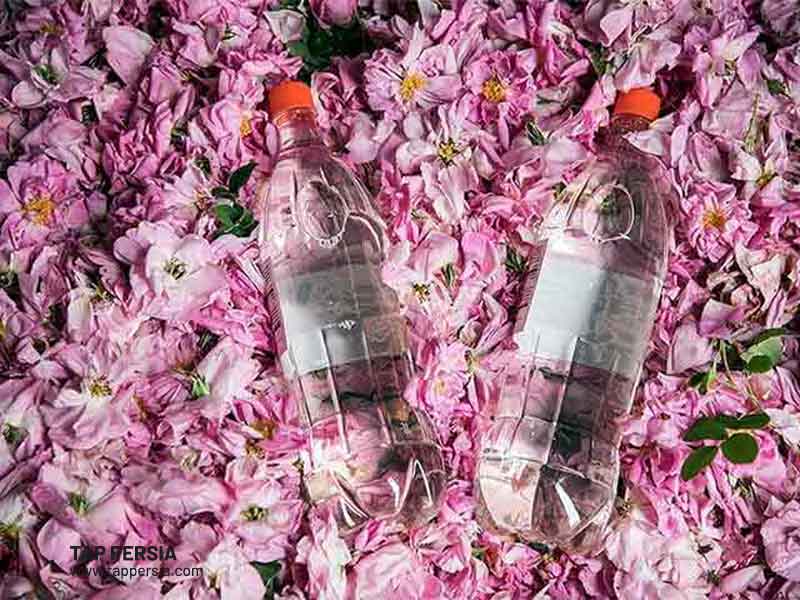
Due to its unique weather, Shiraz is surrounded by lovely gardens, which helped Shiraz become known for its herbal essences. Shiraz is home to many herbal distilleries, which operate successfully. The distillates of orange blossom, Bidmeshk (Pussy willow), rosewater, Nastaran (Rosa canina), etc. are among the most well-known and popular among locals and visitors in Shiraz.
Orange Blossom
The city of Shiraz is awash in the aroma of orange blossoms in the spring, especially in late April and early May. For a period, some of the city’s gardens will be closed as flowers are harvested. A machine is used to gather and distill these blooms. There are herbal medicine shops and markets where dried flowers from these aromatic blooms can be purchased to make jams or teas. These aromatic blooms are also used to make syrup, orange blossom tea, and other things. This can be one of the top Shiraz souvenirs you can keep in mind.
Bidmeshk (Pussy willow) Distillate
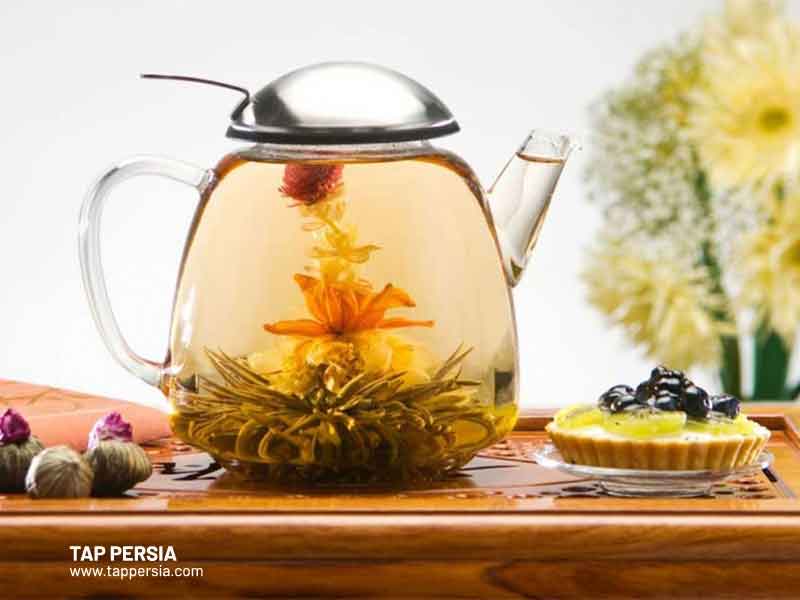
Bidmeshk (Pussy willow), one of the plants tourists search for in Shiraz, is also sold there in juice and syrup form.
Bidmeshk (Pussy willow) was the top flower on the prescription of attars and sages in the not-so-distant past, when attars were the nation’s best-equipped pharmacy. When there was a lack of burdock, they used to collect derivatives from Bidmeshk (Pussy willow) to use its derivatives because of the vast variety of medical virtues it possesses. Actually, bidmeshk, often known as pussy willow, has laxative, nerve, and sexual stimulating properties. This medicinal herb improves digestion and stimulates appetite. This plant’s leaves or bark are decocted to get rid of worms and parasites in the tummy and intestines.
Nastaran (Rosa Canina) Distillate
Rosa Canina, also known as Nastaran, is a lovely and fragrant flower from which an aromatic and useful distillate is made. On sweltering summer days, dried Nastaran drink is frequently advised for comfort and rehydration.
White, flowery white, and pale red are the three hues that Nastaran flowers come in. It was once employed medicinally, and throughout the Middle Ages, it was employed to treat a variety of chest-related illnesses.
Numerous ailments can be treated using the tea and perspiration of the Nastaran plant, which has several therapeutic qualities.
Rosewater

One of the most well-known distillates in Iran is rosewater, which is best produced in the town of Meymand. Rosewater is extracted from the Mohammadi flower and is widely considered a natural antidepressant. It also improves sexual acuity. Additionally, it is utilized in the cosmetics and perfume industries, both of which deal with dermatology. Additionally, it may be used in cooking as a perfect supplement to give meals, beverages, and desserts some delicious taste.
Because there are so many Damask roses in Shiraz and Kashan, rosewater is a symbol of both places. It’s also noteworthy to mention that Mohammadi flowers play an important role in Iranian cuisine.
Handicrafts
Shiraz has a long history that dates back to the ancient past, and because of the many different ethnic groups who have called Shiraz home, the city boasts a variety of beautiful crafts that may be bought as gifts today. One of the most significant cities in Iran for the manufacture of crafts is Shiraz. As Shiraz souvenirs and handicrafts, the talented local artisans produce the most captivating pieces of art. Naturally, a lot of these Iranian trinkets and crafts aren’t exclusive to Shiraz. Here are some examples of local Shiraz handicrafts that you may purchase as a memento of your vacation.
Khatam
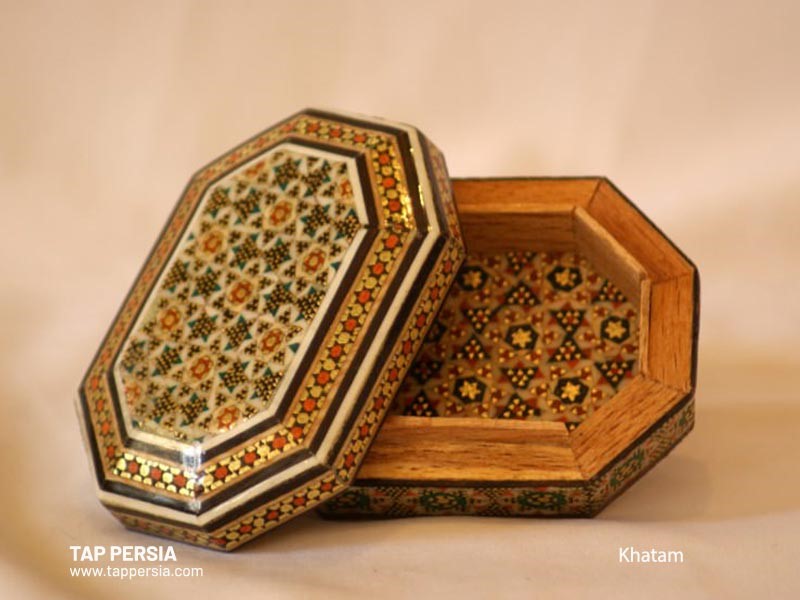
One of the most delicate and exquisite handicrafts is khatam. This priceless Shiraz souvenir is made by joining simple, delicate pieces of wood that are in various hues and forms. Khatam uses a variety of materials, including ivory, bone, wood, and gold, to create his masterpieces.
This ancient craft is incredibly time-consuming and demands accuracy and patience. The marketplaces and shopping areas in Shiraz provide a wide variety of Ghalamdan, beautiful boxes, vases, spoons, forks, paper napkin boxes, and other goods. This art has a lengthy history, and the Safavid era is when it peaked and flourished.
Along with Khatam Kari, other Shiraz mementos include etching (Qalam Zani), earthenware, and vitreous enamel (Mina Kari).
Vitreous Enamel
Metal decoration using colorful pigments is known as vitreous enamel (Mina Kari). These days, this technique is used to embellish the majority of copper objects.
In reality, enameling is the technique of using metal oxides, which have a tendency to change color when heated, to decorate metal tools and items. The use of fire, engraving, and sketching are used to produce the laboratory art of enameling. Each metal produces a unique hue. This art has been around for 5,000 years, and the Safavid era in Iran was when it was at its height (dynasty era).
Every visitor’s eye is drawn to the silver items and plates when exploring the Shiraz marketplaces. You may get many varieties of pottery, candies, cups, and other containers and items as Shiraz souvenirs. Silver is one of the branches of metallurgy, and the Shiraz artisans manufacture these products with remarkable taste and accuracy.
Glassblowing
Silver Objects and Dishes
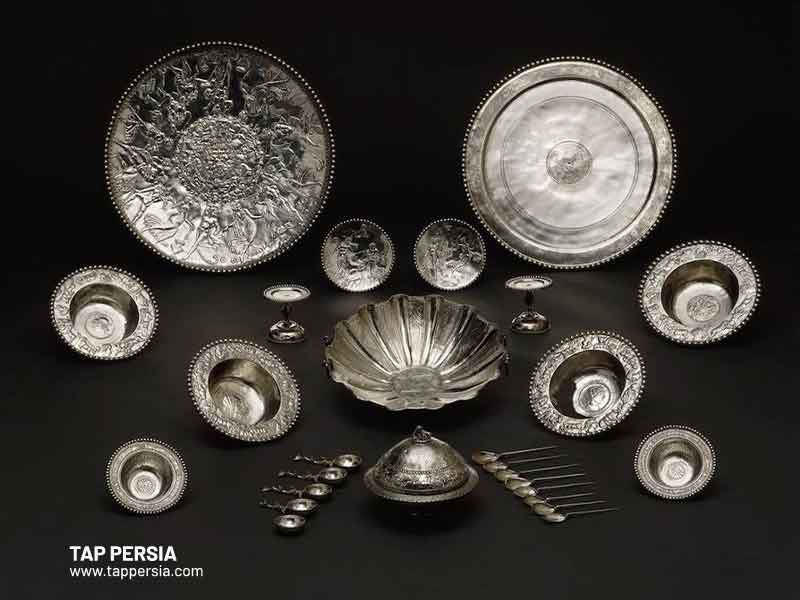
In many regions of the globe, the skill of traditional glassmaking, or glassblowing, is still widely practiced. Glass is created by mixing alkaline silicate and melting it in a furnace. By using a mold, a blowtorch, or by hand, the molten material is shaped.
In Iran, this method of making glassware has a long history. You can still find remnants of old glasses in museums.
Felt Alabaster
One of the hardest kind of work that Shiraz artisans do is felt alabaster. It takes a long procedure to manufacture felt, which is made from camel, goat, or sheep hair. Due to the lack of a warp and the fact that they are composed of wool, these substrates take a long time to create felt from. One of the most valuable pieces of art you can purchase are these Shiraz souvenirs.
Shiraz pottery
One of the oldest crafts, pottery has been a part of Iranian culture for thousands of years prior to the birth of Christianity. Iranians eventually encountered pottery and ceramic items, which grew to be an essential component of their culture.
Shiraz is renowned for its ceramic and pottery production. Here, you can discover a wide range of items in various sizes and designs that may be used both as everyday items and as decorations.
Giveh

Giveh is a pair of lightweight, sturdy shoes that resemble espadrilles. In the past, farmers and villages wore it more frequently. Its characteristics are highly distinctive. As an illustration, it is ideal for dry and hilly locations since it is very light and reduces foot perspiration. It has only one foot; neither the left nor the right are different. These characteristics have made footwear a distinctive product and given it global popularity. Given that it has tiny pores, giveh is typically manufactured from leather, carpet yarn, and other raw materials. These shoes are often white, although they are also available in red, blue, orange, and black.
If you’re searching for a fantastic and unique memento for your family and friends, visit the lovely Givehs in Shiraz.
Wood Carving
A kind of art from the Sassanid era is called monabat kari, commonly known as Iranian wood carving (3rd – 7th centuries AC). One of the most exquisite woodcrafts is wood carving. In actuality, engraving is just wood carving. One of the most delicate Iranian handicrafts is wood carving, which combines art and the pleasure of artists to produce valuable goods from cheap and basic materials. Artists use a few metal hammers and pens to carve their designs into the wood, including Kofi lines, flowers, Khatayi, Slavic motifs, and chicken.
Abadeh, which is located in northern Shiraz, has been listed as a notable Monabat city by UNESCO. Here, tourists may buy a variety of Monabat goods. As a gift for your family or friends, you may purchase a range of engraved items, such as Shiraz mementos.
A Few Last Words
In Iran, Shiraz souvenirs are the most popular items purchased by tourists. Shiraz is after all the cultural and poetic capital of Iran, with a long history dating back to the Paleolithic era. Yes, Shiraz is home to enticing souvenirs in addition to historical sites, grand homes, lyrical mausoleums, and amazing cuisine. So grab your bags and travel to Shiraz to quench your hunger for creative handicrafts or your sweet taste with souvenirs made in this stunning city.




Comment (0)